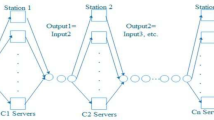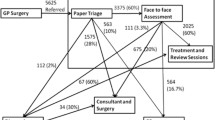Abstract
Case processing tends to be examined with data analysis or evaluation designs. Both limit our understanding of how case processing as a whole operates and how its parts relate to each other. This article suggests queue simulation modeling as a method for dealing with these issues. We report here the initial development and analysis of a queuing model of arraignment to trial assignment. Conceptualizing on the basis of court functions and empirical findings, rather than institutional structures, we conceive a five-stage pretrial process. Using case-level, rather than system-level data, we construct a single-server, multiphase queuing model and use the model to simulate the behavior of a pretrial case processing system. Simulations show the strong impact of the final phase (trial assignment) on the entire system and that most of this impact is delay rather than service. The system is then analyzed using a factorial design that systematically alters model parameters thought to be important determinants of performance. Simulations are run for each possibility in the design, and analysis of variance is used to examine results. Analysis confirms prior results concerning final phase impact and points specifically to the import of phase capacity and exit rate. The utility of modeling is considered by suggesting some policy implications of the results for judicial staffing and behavior.
Similar content being viewed by others
References
Blumstein, A. (1981). Court delay and queueing theory. In Martin, J. A., and Prescott, E. A. (eds.),Appellate Court Delay, National Center for State Courts, Williamsburg, Va, pp. 155–159.
Chaiken, J., Crabill, T., Holliday, L., Jaquette, D., Lawless, M., and Quade, E. (1976).Criminal Justice Models: An Overview, National Institute of Law Enforcement and Criminal Justice, Washington, D.C.
Church, T. W. (1982)Examining Local Legal Culture, United States Department of Justice, Washington, D.C.
Church, T. W., Carlson, A., Lee, J., and Tan, T. (1978).Justice Delayed: The Pace of Litigation in Urban Trial Courts, National Center for State Courts, Williamsburg, Va.
Eisenstein, J., and Jacob, H. (1977).Felony Justice: An Organizational Analysis of Criminal Courts, Little, Brown, Boston.
Hemming, R. B., Nardulli, P. F., and Eisenstein, J. (1987). The Timing of Justice in Felony Trial Courts, Unpublished manuscript, University of Illinois, Urbana.
Hann, R. G. (1973).Decision Making in the Canadian Criminal Court System: A Systems Analysis, Centre of Criminology, University of Toronto, Toronto.
Jacobs, N., and Chayet, E., with Meara, C. (1986).Bang the Gavel Slowly, John Jay College, CUNY, New York.
Jennings, J. B. (1971a).Quantitative Models of Criminal Courts. New York City Rand Institute, New York.
Jennings, J. B. (1971b).The Flow of Arrested Adult Defendants Through the Manhattan Criminal Courts in 1968 and 1969, New York City Rand Institute, New York.
Luskin, M. L., and Luskin, R. C. (1986). Why so fast, why so slow? Explaining case processing time.J. Crim. Law Criminol. 77: 190–214.
Luskin, M. L., and Luskin, R. C. (1987). Case processing times in three courts.Law Policy 9: 207–232.
Mahoney, B., Sipes, L. L., and Ito, J. A. (1985).Implementing Delay Reduction and Delay Prevention Programs in Urban Trial Courts, National Center for State Courts, Williamsburg, Va.
Nagel, S., Beeman, M., and Reed, J. (1986). Optimum sequencing of court cases to reduce delay.Univ. Ala. Law Rev. 37: 583–638.
Navarro, J. A., and Taylor, J. G. (1967). Data analyses and simulation of court system in the District of Columbia for the processing of felony defendants. In President's Report on Law Enforcement and Administration of Justice,Science and Technology, U.S. Government Printing Office, Washington, D.C., pp. 199–215.
Neubauer, D. W. (1974).Criminal Justice in Middle America, General Learning Press, Morristown, N.J.
Neubauer, D. W., Lipetz, M., Luskin, M. L., and Ryan, J. P. (1981a).Managing the Pace of Justice, National Institute of Justice, Washington, D.C.
Neubauer, D. W., Lipetz, M., Luskin, M. L., and Ryan, J. P. (1981b).Managing the Pace of Justice: Executive Summary, National Institute of Justice, Washington, D.C.
Nimmer, R. T. (1976).The Nature of System Change, American Bar Foundation, Chicago.
Reed, J. H. (1973).The Application of Operations Research to Court Delay, Praeger, New York.
Resnick, J. (1982). Managerial judges.Harvard Law Rev. 96: 374–448.
Sipes, L. L., Carlson, A., Tan, T., Aikon, A. A., and Page, R. W. (1980).Managing to Reduce Delay, National Center for State Courts, Williamsburg, Va.
Watson, H. J. (1981).Computer Simulation in Business, John Wiley & Sons, New York.
Author information
Authors and Affiliations
Rights and permissions
About this article
Cite this article
McAllister, W., Atchinson, J. & Jacobs, N. A simulation model of pretrial felony case processing: A queuing system analysis. J Quant Criminol 7, 291–314 (1991). https://doi.org/10.1007/BF01063235
Issue Date:
DOI: https://doi.org/10.1007/BF01063235




